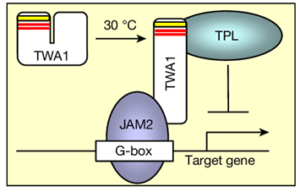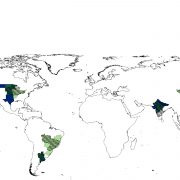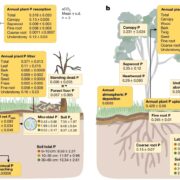Beat the heat with TWA1, a novel thermosensor in plants
 Optimal temperatures for growth and development vary between plant species, making accurate temperature sensing crucial for their fitness. The search for molecular mechanisms underlying temperature signaling suggests that a single temperature sensor likely does not exist in plants. Instead, plants possess a variety of thermosensors, including photosensing-related proteins, RNA thermosensors, and even thermosensitive plasma membranes. In a recent study, Bohn and co-authors identified a novel thermosensor, THERMO-WITH ABA-RESPONSE 1 (TWA1), from a screen for mutants exhibiting ABA hypersensitivity. TWA1 is an intrinsically disordered protein with a highly variable amino-terminal region, which is believed to undergo a temperature-dependent conformational change. This change allows TWA1 nuclear translocation where it interacts with the TOPLESS – JASMONATE-ASSOCIATED MYC-LIKE 2 (TPL-JAM2) co-repressor complex to regulate gene expression and protect plants from heat stress. Interestingly, specific amino acid changes in the amino-terminal region of TWA1 orthologues were linked to different temperature thresholds, related to the climatic conditions where these species grow. Notably, the generation of thermotolerant plants through the overexpression of TWA1 did not negatively impact growth, unlike previously used transgenic strategies that often lead to growth or yield penalties. Therefore, a rational design of a TWA1 gene-editing strategy for generating crops with altered thermal acclimation responses offers a tremendous potential to combat the harmful effects of climate change (Summary by Thomas Depaepe @thdpaepe) Nature 10.1038/s41586-024-07424-x.
Optimal temperatures for growth and development vary between plant species, making accurate temperature sensing crucial for their fitness. The search for molecular mechanisms underlying temperature signaling suggests that a single temperature sensor likely does not exist in plants. Instead, plants possess a variety of thermosensors, including photosensing-related proteins, RNA thermosensors, and even thermosensitive plasma membranes. In a recent study, Bohn and co-authors identified a novel thermosensor, THERMO-WITH ABA-RESPONSE 1 (TWA1), from a screen for mutants exhibiting ABA hypersensitivity. TWA1 is an intrinsically disordered protein with a highly variable amino-terminal region, which is believed to undergo a temperature-dependent conformational change. This change allows TWA1 nuclear translocation where it interacts with the TOPLESS – JASMONATE-ASSOCIATED MYC-LIKE 2 (TPL-JAM2) co-repressor complex to regulate gene expression and protect plants from heat stress. Interestingly, specific amino acid changes in the amino-terminal region of TWA1 orthologues were linked to different temperature thresholds, related to the climatic conditions where these species grow. Notably, the generation of thermotolerant plants through the overexpression of TWA1 did not negatively impact growth, unlike previously used transgenic strategies that often lead to growth or yield penalties. Therefore, a rational design of a TWA1 gene-editing strategy for generating crops with altered thermal acclimation responses offers a tremendous potential to combat the harmful effects of climate change (Summary by Thomas Depaepe @thdpaepe) Nature 10.1038/s41586-024-07424-x.









